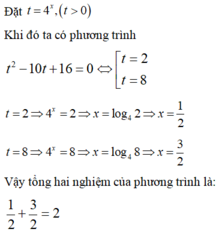
Hãy nhập câu hỏi của bạn vào đây, nếu là tài khoản VIP, bạn sẽ được ưu tiên trả lời.


1.
PT $\Leftrightarrow 2^{x^2-5x+6}+2^{1-x^2}-2^{7-5x}-1=0$
$\Leftrightarrow (2^{x^2-5x+6}-2^{7-5x})-(1-2^{1-x^2})=0$
$\Leftrightarrow 2^{7-5x}(2^{x^2-1}-1)-(2^{x^2-1}-1)2^{1-x^2}=0$
$\Leftrightarrow (2^{x^2-1}-1)(2^{7-5x}-2^{1-x^2})=0$
$\Rightarrow 2^{x^2-1}-1=0$ hoặc $2^{7-5x}-2^{1-x^2}=0$
Nếu $2^{x^2-1}=1\Leftrightarrow x^2-1=0$
$\Leftrightarrow x^2=1\Leftrightarrow x=\pm 1$
$2^{7-5x}-2^{1-x^2}=0$
$\Leftrightarrow 7-5x=1-x^2\Leftrightarrow x^2-5x+6=0$
$\Leftrightarrow (x-2)(x-3)=0\Leftrightarrow x=2; x=3$
2. Đặt $\sin ^2x=a$ thì $\cos ^2x=1-a$. PT trở thành:
$16^a+16^{1-a}=10$
$\Leftrightarrow 16^a+\frac{16}{16^a}=10$
$\Leftrightarrow (16^a)^2-10.16^a+16=0$
Đặt $16^a=x$ thì:
$x^2-10x+16=0$
$\Leftrightarrow (x-2)(x-8)=0$
$\Leftrightarrow x=2$ hoặc $x=8$
$\Leftrightarrow 16^a=2$ hoặc $16^a=8$
$\Leftrightarrow 2^{4a}=2$ hoặc $2^{4a}=2^3$
$\Leftrightarroww 4a=1$ hoặc $4a=3$
$\Leftrightarrow a=\frac{1}{4}$ hoặc $a=\frac{3}{4}$
Nếu $a=\frac{1}{4}\Leftrightarrow \sin ^2x=\frac{1}{4}$
$\Leftrightarrow \sin x=\pm \frac{1}{2}$
Nếu $a=\sin ^2x=\frac{3}{4}\Rightarrow \sin x=\pm \frac{\sqrt{3}}{2}$
Đến đây thì đơn giản rồi.

Đặt \(t=2^x\left(t>0\right)\) thì phương trình trở thành
\(4t^2-2t.4-\left(t^4+2t^3\right)=0\)
Bây giờ coi 4=u là một ẩn của phương trình, còn t là số đã biết. Phương trình trở thành phương trình bậc 2 đối với ẩn u. Tính \(\Delta'\)
ta có :
\(\Delta'=\left(-t\right)^2+\left(t^4+2t^3\right)=\left(t^2+t\right)^2\)
Do đó :
\(\begin{cases}u=t-t\left(t+1\right)\\u=t+t\left(t+1\right)\end{cases}\) \(\Leftrightarrow\begin{cases}4=-t^2\\4=t^2+2t\end{cases}\) \(\Leftrightarrow t^2+2t-4=0\)
\(\Leftrightarrow\begin{cases}t=-1-\sqrt{5}\\t=-1+\sqrt{5}\end{cases}\)
Suy ra \(2^x=\sqrt{5}-1\Leftrightarrow x=\log_2\left(\sqrt{5}+1\right)\)


Với t = log 2 x . Ta có phương trình đã cho tương đương với phương trình:



Không biết em có làm sai không:
ĐKXĐ: \(x,y\ge0\).
Đặt 2x = a; 3y = b.
HPT trở thành:
\(\left\{{}\begin{matrix}\left(\sqrt{5}\right)^a-\left(\sqrt{5}\right)^b+\left(a-b\right)\left(ab+12\right)=0\\a^2+b^2=16\end{matrix}\right.\)
\(\Leftrightarrow\left\{{}\begin{matrix}a^2+b^2=16\\\left(\sqrt{5}\right)^a-\left(\sqrt{5}\right)^b+\left(b-a\right)\left(a^2+b^2\right)+a^3-b^3+12\left(a-b\right)=0\end{matrix}\right.\)
\(\Leftrightarrow\left\{{}\begin{matrix}a^2+b^2=16\\\left(\sqrt{5}\right)^a+a^3-4a=\left(\sqrt{5}\right)^b+b^3-4b=0\left(1\right)\end{matrix}\right.\).
Giả sử \(a\ge b\Rightarrow\left(\sqrt{5}\right)^a\ge\left(\sqrt{5}\right)^b\). Mà \(\left(a^3-4a\right)-\left(b^3-4b\right)=\left(a-b\right)\left(a^2+ab+b^2-4\right)\ge0\) nên VT(1) \(\ge\) VP(1).
Do đẳng thức xảy ra nên ta có a = b. Thay vào ta tìm được a = b = \(2\sqrt{2}\) nên \(x=\sqrt{2};y=\dfrac{2\sqrt{2}}{3}\).
\(\left\{{}\begin{matrix}\left(\sqrt{5}\right)^{2x}-\left(\sqrt{5}\right)^{3y}=\left(3y-2x\right)\left(6xy+12\right)\left(1\right)\\4x^2+9y^2=16\left(2\right)\end{matrix}\right.\)
\(\left(2\right)\Rightarrow4x^2+9y^2-4=12\) the vo (1)
\(\Rightarrow\left(\sqrt{5}\right)^{2x}-\left(\sqrt{5}\right)^{3y}=\left(3y-2x\right)\left(6xy+4x^2+9y^2-4\right)\)
\(\Leftrightarrow\left(\sqrt{5}\right)^{2x}-\left(\sqrt{5}\right)^{3y}=27y^3-8x^3-12y+8x\)
\(\Leftrightarrow\left(\sqrt{5}\right)^{2x}+\left(2x\right)^3-4.\left(2x\right)=\left(\sqrt{5}\right)^{3y}+\left(3y\right)^3-4.\left(3y\right)\left(3\right)\)
Xét hàm số \(f\left(t\right)=\left(\sqrt{5}\right)^{2t}+\left(2t\right)^3-4.2t\) đồng biến trên R
\(\Rightarrow\left(3\right):f\left(2x\right)=f\left(3y\right)\Leftrightarrow\left\{{}\begin{matrix}2x=3y\\4x^2+9y^2=16\end{matrix}\right.\Leftrightarrow\left\{{}\begin{matrix}x=\sqrt{2}\\y=\dfrac{2\sqrt{2}}{3}\end{matrix}\right.\)

